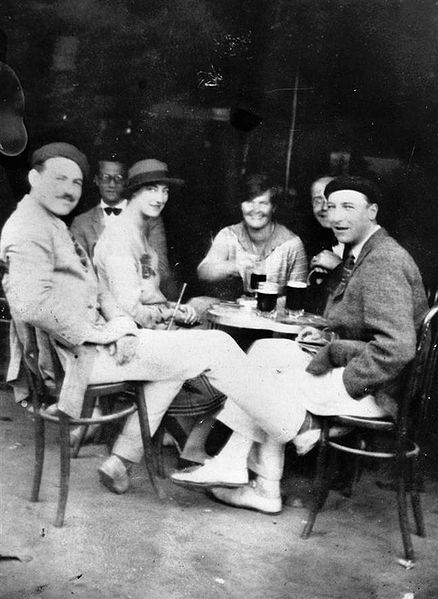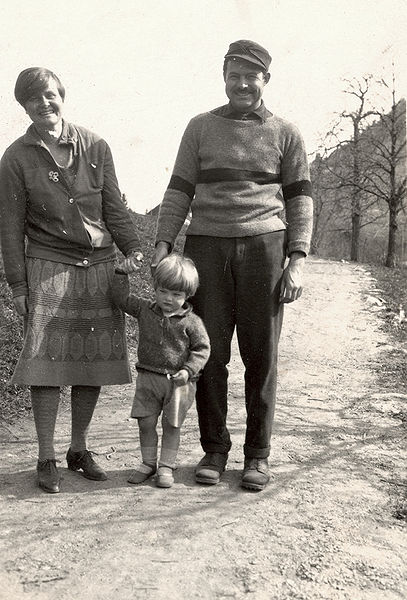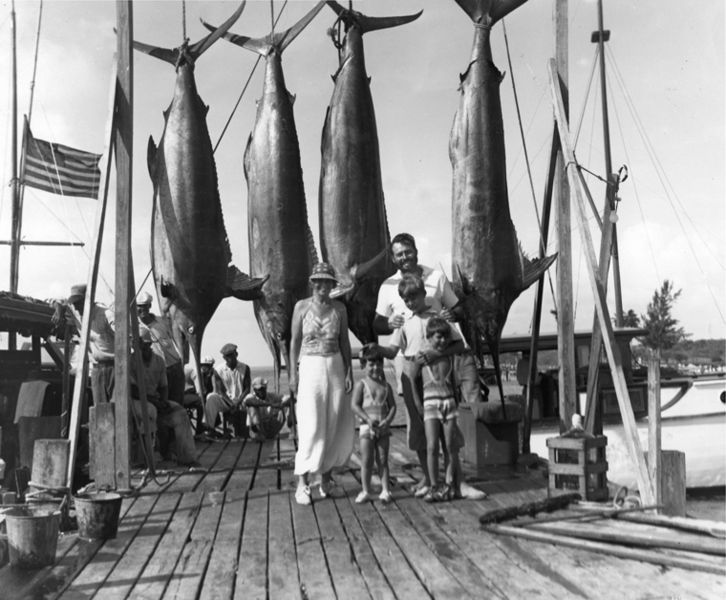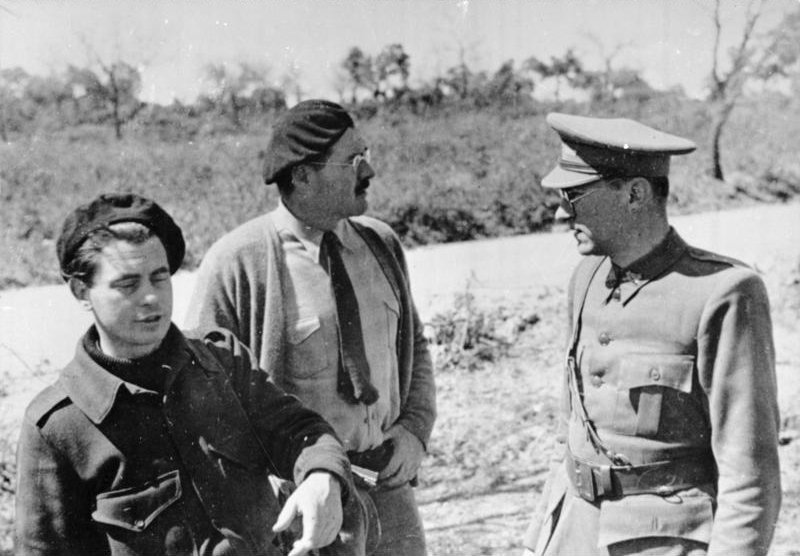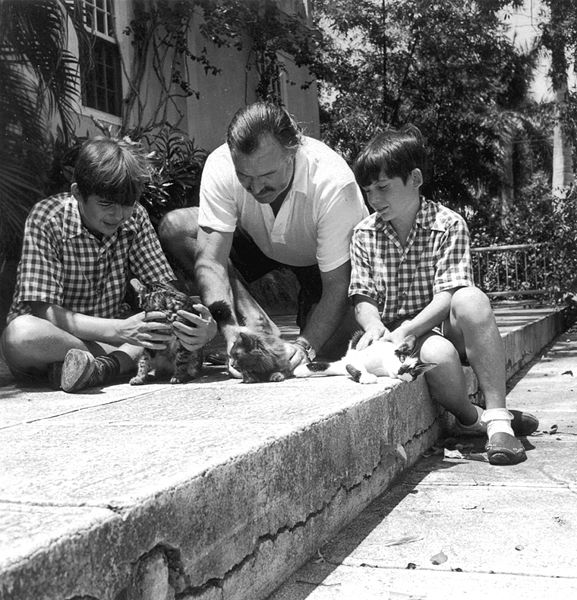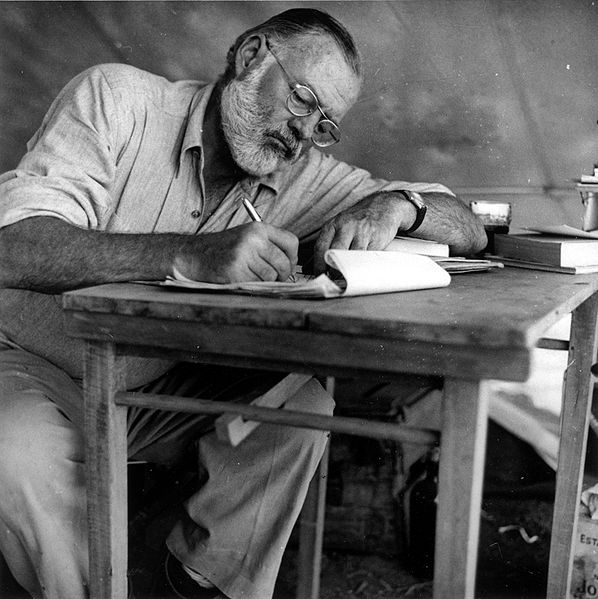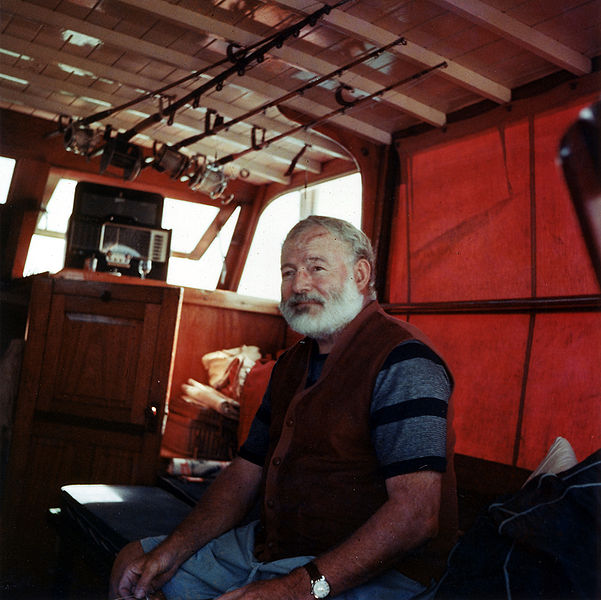<Back to Index>
- Journalist and Media Owner Paul Julius Freiherr von Reuter, 1816
- Writer Ernest Miller Hemingway, 1899
- Romanian Revolutionary Simion Bărnuțiu, 1808
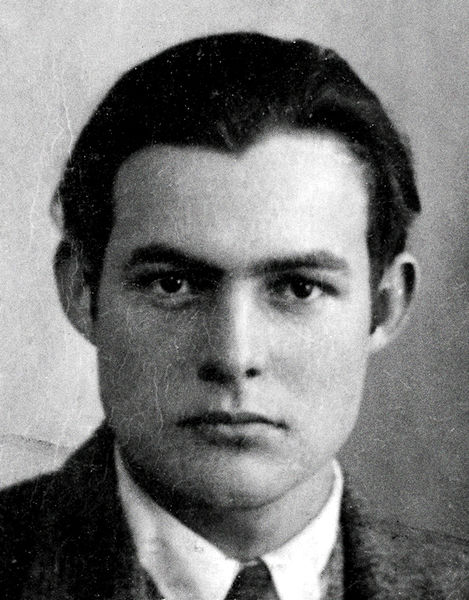
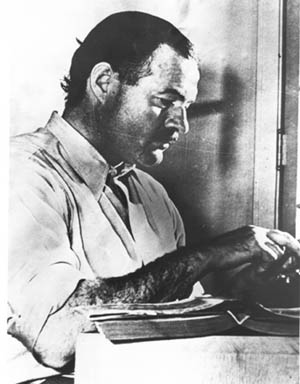
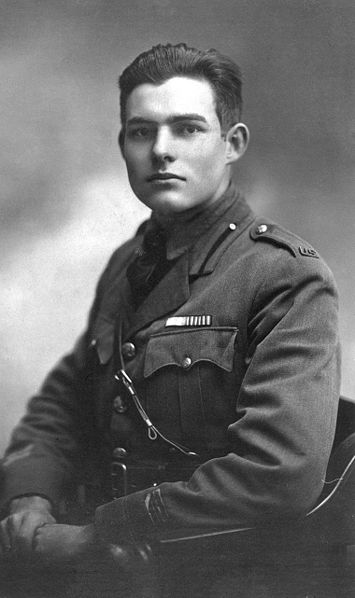
Ernest Miller Hemingway (July 21, 1899 – July 2, 1961) was an American writer and journalist. During his lifetime he had seven novels, six collections of short stories, and two works of non-fiction published, with a further three novels, four collections of short stories, and three non-fiction autobiographical works published after his death. Hemingway's distinctive writing style characterized by economy and understatement had an enormous influence on 20th-century fiction, as did his apparent life of adventure and the public image he cultivated. Hemingway produced most of his work between the mid-1920s and the mid-1950s, culminating in his 1954 Nobel Prize in Literature. Hemingway's protagonists are typically stoical men who exhibit an ideal described as "grace under pressure"; many of his works are considered classics of American literature.
Hemingway was born and raised in Oak Park, Illinois. After leaving high school he worked for a few months as a reporter, before leaving for the Italian front to become an ambulance driver during World War I; he was seriously injured and returned home within the year. In 1922 Hemingway married Hadley Richardson, the first of his four wives, and the couple moved to Paris, where he worked as a foreign correspondent. During his time there he met and was influenced by writers and artists of the 1920s expatriate community known as the "Lost Generation". His first novel, The Sun Also Rises, was written in 1924. After divorcing Hadley Richardson in 1927 Hemingway married Pauline Pfeiffer; they divorced following Hemingway's return from covering the Spanish Civil War, after which he wrote For Whom the Bell Tolls. Martha Gellhorn became his third wife in 1940, but he left her for Mary Welsh Hemingway after World War II, during which he was present at D-Day and the liberation of Paris. Shortly after the publication of The Old Man and the Sea in
1952 Hemingway went on safari to Africa, where he was almost killed in
a plane crash that left him in pain or ill-health for much of the rest
of his life. Hemingway had permanent residences in Key West, Florida, and Cuba during the 1930s and 40s, but in 1959 he moved from Cuba to Idaho, where he committed suicide in the summer of 1961. Ernest Miller Hemingway was born on July 21, 1899 in Oak Park, Illinois, a suburb of Chicago. His
father, Clarence Edmonds Hemingway, was a physician and his mother,
Grace Hall–Hemingway (she hyphenated her last name), a musician, both
well-educated and well-respected in the conservative community of Oak
Park. When Clarence and Grace Hemingway married in 1896, they moved in with Grace's father, Ernest Hall, after
whom they named their first son. Hemingway later claimed to dislike his
given name, which he "associated with the naive, even foolish hero of Oscar Wilde's play The Importance of Being Earnest". The
family's seven bedroom home in a respectable neighborhood contained a
music studio for Grace and a medical office for Clarence. Hemingway's
mother, a classically trained musician, frequently performed in
concerts around the village. As an adult Hemingway professed to hate
his mother, although biographer Michael Reynolds points out that
Hemingway mirrored her energy and enthusiasm. Her
insistence that he learn the cello became a "source of conflict", but
he admitted the music lessons were useful to his writing, as in the "contrapunctal structure of For Whom the Bell Tolls. The family owned a summer home called Windemere on Walloon Lake, near Petoskey, Michigan, which they visited during the summers. There Hemingway learned to hunt, fish, and camp in the woods and lakes of Northern Michigan.
His early experiences with nature instilled a lasting passion for
outdoor adventure, living in remote or isolated areas, hunting and
fishing. His
father Clarence instructed him in the outdoor life until depression
caused him to become reclusive when Hemingway was about 12-years-old.
Hemingway attended Oak Park and River Forest High School from
1913 until 1917. He took part in a number of sports — boxing, track,
water polo, and football — and had good grades in English classes. He and his sister Marcelline performed in the school orchestra for two years. Beginning
in his junior year, Hemingway wrote and edited the "Trapeze" and
"Tabula" (the school's newspaper and yearbook), in which he imitated
the language of sportswriters, and sometimes used the pen name Ring Lardner, Jr., a nod to his literary hero Ring Lardner of the Chicago Tribune, who used the byline "Line O'Type". Like Mark Twain, Stephen Crane, Theodore Dreiser and Sinclair Lewis, Hemingway worked as a journalist before becoming a novelist; after leaving high school he was hired as a cub reporter for The Kansas City Star, where he quickly learned that the truth often lurks below the surface of a story. Although he worked at the newspaper for only six months from October 17, 1917, to April 30, 1918, he relied on the Star's style guide as
a foundation for his writing: "Use short sentences. Use short first
paragraphs. Use vigorous English. Be positive, not negative."
Hemingway returned home in early 1919 and spent the summer in Michigan, fishing and camping with high school friends. In
September he left for the back country with two friends to fish and
camp for a week. The trip became the inspiration for his short story "Big Two-Hearted River", in which Nick Adams takes to the country to find solitude after his return from war. Late in the year he moved to Toronto and began to write for the Toronto Star Weekly as a freelancer, staff writer, and foreign correspondent. In the fall of 1920, after having spent the summer in Michigan, he moved to Chicago for a short period while still filing stories for the Toronto Star. In Chicago he worked as associate editor of the monthly journal Co-operative Commonwealth and met Hadley Richardson, eight years older than him (and one year older than Agnes). After a few months Hadley and Hemingway decided to marry, planning a honeymoon in Europe; Sherwood Anderson convinced them to visit Paris, a city quickly attracting expatriate artists largely because of the good exchange rates. Hemingway married Hadley on September 3, 1921. Two months later Hemingway became a foreign correspondent for the Toronto Star and the couple left for Paris.
Anderson wrote letters of introduction for Hemingway to Gertrude Stein and other writers in Paris. Stein, who became Hemingway's mentor for a period and introduced him to the Expatriate Modernists of the Montparnasse Quarter, referred to the young artists as the "Lost Generation" a term Hemingway popularized with the publication of The Sun Also Rises. A regular at Stein's salon, Hemingway met young and newly influential artists such as Pablo Picasso, Joan Miro, and Juan Gris. Eventually
Hemingway withdrew from Stein's influence and their relationship
deteriorated into a literary quarrel that spanned decades. During this period Ezra Pound mentored the young writer. Hemingway
met Pound in February 1922, toured Italy with him in 1923, and lived on
the same street in 1924. The two forged a strong friendship, and in
Hemingway Pound recognized, and fostered, a talented writer. A popular gathering place for writers was Sylvia Beach's Shakespeare and Company. She published James Joyce's Ulysses, and Hemingway met Joyce there in March 1922. The two writers frequently embarked on "alcoholic sprees". Hemingway
and Hadley lived in a small walk-up on the Rue de Cardinal Lemoine, and
he worked in a rented room in a nearby building. During his first 20 months in Paris, Hemingway filed 88 stories for the Toronto Star. He covered the Greco-Turkish War where he witnessed the burning of Smyrna;
he wrote travel pieces such as "Tuna Fishing in Spain", "Trout Fishing
All Across Europe: Spain Has the Best, Then Germany"; and he wrote about bullfighting — "Pamplona in July; World's Series of Bull Fighting a Mad, Whirling Carnival". Hemingway
was devastated on learning that Hadley had lost a suitcase filled with
his manuscripts at the Gare de Lyons as she was travelling to Geneva to meet him in December 1922. A month later, because Hadley was pregnant, the couple returned to Toronto, where their son John Hadley Nicanor was born on October 10, 1923. During their absence Hemingway's first book was published, Three Stories and Ten Poems.
Two of the stories it contained were all that remained of his work
after the loss of the suitcase, and the third had been written the
previous spring in Italy. Within months a second volume, in our time (without
capitals), was published. The small volume included six vignettes and a
dozen stories Hemingway had written the previous summer during his
first visit to Spain.
Hadley, Hemingway, and their son (nicknamed Bumby), returned to Paris
in January 1924 and moved into a new apartment on the Rue Notre Dame
des Champs. Hemingway helped Ford Madox Ford edit The Transatlantic Review, in which works by Pound, John Dos Passos, and Gertrude Stein were published, as well as some of Hemingway's own early stories such as "Indian Camp". When "In Our Time" (with capital letters) was published in 1925 the dust jacket had comments from Ford. Six months earlier, Hemingway met F. Scott Fitzgerald, and the pair formed a friendship of "admiration and hostility". In the summer of 1925, Hemingway and Hadley went on their annual visit to Pamplona for the Festival of San Fermín, accompanied by a group of American and British ex-patriates. The trip inspired Hemingway's first novel, The Sun Also Rises, which he began to write immediately after the fiesta, finishing it September. He decided to slow down for the revision process and devoted all of that fall and winter to the rewrite. The revised manuscript arrived in New York in April, and Hemingway corrected the final proof in Paris in August 1926. Scribner's published the novel in October. Hemingway's marriage to Hadley broke down as he was writing and revising The Sun Also Rises. In the spring of 1926, Hadley became aware of his affair with Pauline Pfeiffer, although
she had endured Pauline's presence in Pamplona that July. However, on
their return to Paris Hadley and Hemingway decided to separate, and
Hadley formally requested a divorce in the fall. By November they had
split their possessions, and Hadley accepted Hemingway's offer of the
proceeds from The Sun Also Rises. The couple were divorced in January 1927, and Hemingway married Pauline Pfeiffer in May. Pauline was from Arkansas — her family was wealthy and Catholic — and before their marriage Hemingway converted to Catholicism. In Paris she worked for Vogue. After a honeymoon in Grau-du-Roi, where he contracted anthrax, Hemingway settled in Paris and planned his next collection of short stories, Men Without Women, published in October 1927. By the end of the year Pauline was pregnant, and wanted to move back to America to have her baby. John Dos Passos recommended Key West;
in March 1928, they left Paris. Some time that spring Hemingway
suffered a severe injury in their Paris bathroom, when he pulled a
skylight down on his head thinking he was pulling on a toilet chain.
This left him with a prominent forehead scar, subject of numerous
legends, which he carried for the rest of his life. When Hemingway was
asked about the scar he was reluctant to answer. After his departure from Paris, Hemingway "never again lived in a big city". In the late spring Hemingway and Pauline travelled to Kansas City where their son Patrick Hemingway was born on June 28, 1928. Pauline had a difficult delivery, which Hemingway fictionalized in A Farewell to Arms. After Patrick's birth, Pauline and Hemingway travelled to Wyoming, Massachusetts and New York. In
the fall he was in New York with Bumby, about to board a train to
Florida, when he received a cable telling him that his father had
committed suicide. Hemingway worked on the draft of A Farewell to Arms during 1928. It was finished by late summer, but he delayed for a few months
before revising it. By the winter of 1929 the serialization in Scribner's magazine
was set for May, but that spring Hemingway continued to work on the
book's ending in France, which he may have rewritten as many as
seventeen times. When the book was published on September 27 Hemingway's stature as an American writer was secured. In France and Spain during the summer of 1929 he gathered material for his next work, Death in the Afternoon. During
the early 1930s Hemingway spent his winters in Key West and summers in
Wyoming, where he found "the most beautiful country he had seen in the
American West" and hunting that included deer, elk, and grizzly bear.
His third son, Gregory Hancock Hemingway, was born on November 12, 1931 in Kansas City. Pauline's
uncle bought the couple a house in Key West where the second floor of
the carriage house was converted to a writing den. While in Key West he enticed his male friends to join him on fishing expeditions — inviting his longtime friends Waldo Peirce, John Dos Passos, and Max Perkins — with one all male trip to the Dry Tortugas, and he relaxed at Sloppy Joe's. In 1933 Hemingway and Pauline went on safari to East Africa, a 10-week trip that provided material for Green Hills of Africa as well as the short stories "The Snows of Kilimanjaro" and "The Short Happy Life of Francis Macomber". They visited Mombasa, Nairobi, and Machakos in Kenya, then Tanganyika where they hunted in the Serengeti, around Lake Manyara and west and southeast of the present-day Tarangire National Park. Hemingway contracted amoebic dysentery that
caused a prolapsed intestine and he was evacuated by plane to Nairobi,
an experience reflected in "The Snows of Kilimanjaro". Their guide was
the noted "white hunter" Philip Hope Percival, who had guided Theodore Roosevelt on his 1909 safari. On his return to Key West in early 1934 Hemingway began work on Green Hills of Africa, published in 1935 to mixed reviews. Back in Key West, Hemingway bought a boat in 1934, named it the Pilar, and began sailing the Caribbean. In 1935 he discovered Bimini, where he spent a considerable amount of time. During this period he also worked on To Have and Have Not, published in 1937 while he was in Spain, the only novel he wrote during the 1930s. In 1937 Hemingway reported on the Spanish Civil War for the North American Newspaper Alliance (NANA). He arrived in France in March, and in Spain ten days later with Dutch filmmaker Joris Ivens. Ivens, who was filming The Spanish Earth, needed Hemingway as a screenwriter to replace John Dos Passos, who left the project when his friend José Robles was arrested and later executed. The
incident changed Dos Passos' opinion of the republicans, which created
a rift between him and Hemingway, who spread a rumor that Dos Passos
was a coward for leaving Spain. Journalist Martha Gellhorn, whom Hemingway met in Key West in 1936, joined him in Spain. While in Madrid with Gellhorn, Hemingway wrote the play The Fifth Column during the bombardment of Madrid late in 1937. He returned to Key West for a few months, then back to Spain in 1938 where he was present at the Battle of the Ebro,
the last republican stand. With fellow British and American
journalists, Hemingway rowed the group across the river, some of the
last to leave the battle. Hemingway and Martha Gellhorn moved to Cuba in 1939, and in 1940 bought the "Finca Vigia" ("Lookout Farm"), which they had been renting. A few months later Hemingway divorced Pauline and married Martha. As he had after his divorce from Hadley, he changed locations: he moved his primary summer residence to Ketchum, Idaho, just outside the newly built resort of Sun Valley; and his winter residence to Cuba. He was at work on For Whom the Bell Tolls, which he started in March 1939, finished in July 1940, and was published in October 1940. Consistent with his pattern of moving around while working on a manuscript, he wrote For Whom the Bell Tolls in Cuba, Wyoming, and Sun Valley. For Whom the Bell Tolls became a book-of-the-month choice, sold half a million copies within months, was nominated for a Pulitzer Prize, and became a literary triumph for Hemingway. In January 1941 Martha was sent to China on assignment for Collier's magazine, and Hemingway accompanied her. Although Hemingway wrote dispatches for PM, he had little affinity for China. However, in the recently-published Spies: The Rise and Fall of the KGB in America,
co-written by John Earl Haynes, Harvey Klehr and Alexander Vassilev, it
is alleged that Hemingway's KGB file identifies him as "Agent Argo". He
was apparently recruited in 1941 before the trip to China, but he
ultimately failed to "give [the Russians] any political information"
and was not "verified in practical work". Contact with "Argo" ceased by
1950. Hemingway returned to Cuba on the outbreak of World War II, and refitted the Pilar to hunt down German submarines. From June to December 1944 he was in Europe, at the D-Day landing
after which he attached himself to "the 22nd Regiment commanded by Col.
Charles 'Buck' Lanaham as it drove toward Paris", and he led a small
band of village militia in Rambouillet outside of Paris. Of
Hemingway's exploits, War II historian Paul Fussell remarks: "Hemingway
got into considerable trouble playing infantry captain to a group of
Resistance people that he gathered because a correspondent is not
supposed to lead troops, even if he does it well". On August 25 he was present at the liberation of Paris,
although the assertion that he was first in the city, or that he
liberated the Ritz is considered part of the Hemingway legend. While in Paris he attended a reunion hosted by Sylvia Beach and made up his long-running feud with Gertrude Stein. Hemingway was present at heavy fighting in the Hürtgenwald at the end 1944. When Hemingway arrived in Europe, he met Time magazine correspondent Mary Welsh in London. During
the war his marriage to Martha disintegrated; the last time he saw her
was in March 1945 as he was preparing to return to Cuba. In 1947 Hemingway was awarded a Bronze Star for
his bravery during World War II. His valor for having been "under
fire in combat areas in order to obtain an accurate picture of
conditions" was recognized, with the commendation that "through his
talent of expression, Mr. Hemingway enabled readers to obtain a vivid
picture of the difficulties and triumphs of the front-line soldier and
his organization in combat". Of his writing career, Hemingway stated from 1942 to 1945 he "was out of business as a writer." In 1946 he married Mary Welsh, who had an ectopic pregnancy five
months later. Hemingway and Mary had a series of accidents and health
problems after the war: in a 1945 car accident he "smashed his knee"
and sustained another "deep wound on his forehead"; Mary broke her
right ankle and then her left ankle in successive skiing accidents. In
1947 his sons Patrick and Gregory were in a car accident, leaving
Patrick with a head wound and severely ill. He became depressed as his literary friends died: in 1939 Yeats and
Ford Madox Ford; in 1940 Scott Fitzgerald; in 1941 Sherwood Anderson
and James Joyce; in 1946 Gertrude Stein; and the following year in
1947, Max Perkins, Hemingway's long time editor and friend. During
this period he had severe headaches, high blood pressure, weight
problems, and eventually diabetes — much of which was the result of
previous accidents and heavy drinking. Nonetheless, early in 1946 he began work on The Garden of Eden with 800 pages finished by June. During
the post–war years he also began work on a trilogy to be called "The
Land", "The Sea" and "The Air" which he intended to combine in one
novel known as The Sea Book.
However, both projects stalled and biographer James Mellow considers
his inability to continue "a symptom of his troubles" during these
years. In
1948 Hemingway and Mary travelled to Europe. While visiting Italy he
returned to the site of his World War I accident, and shortly
afterwards he began work on Across the River and Into the Trees, which he worked on through 1949; it was published in 1950 to bad reviews. A year later he wrote the draft of Old Man and the Sea in eight weeks, considering it "the best I can write ever for all of my life". The Old Man and the Sea became a book-of-the month selection, made Hemingway an international celebrity, and won the Pulitzer Prize in May 1952, a month before he left for his second trip to Africa. In Africa he was seriously injured in two successive plane crashes: he sprained his right shoulder, arm, and left leg; had a concussion; temporarily lost vision in his left eye and the hearing in his left ear; suffered paralysis of the spine; had a crushed vertebra,
ruptured liver, spleen and kidney; and sustained first degree burns on
his face, arms, and leg. Some American newspapers published his
obituary, believing he had been killed. A month later he was again
badly injured in a bush fire accident, which left him with second degree burns on his legs, front torso, lips, left hand and right forearm. Back in Cuba, in October 1954 Hemingway received the Nobel Prize in Literature. Politely he mentioned Carl Sandburg and Isak Dinesen, who in his opinion, deserved the prize. The prize money was welcome, he told reporters. Because
he was in pain as a result of the African accidents, and he had
recently returned home to Cuba after an absence of almost a year,
Hemingway chose not to travel to Stockholm to accept the prize in person. Instead
he sent a speech to be read in which he defines the writer's life:
"Writing, at its best, is a lonely life. Organizations for writers
palliate the writer's loneliness but I doubt if they improve his
writing. He grows in public stature as he sheds his loneliness and
often his work deteriorates. For he does his work alone and if he is a
good enough writer he must face eternity, or the lack of it, each day." As a result of the severe accidents and injuries he sustained in Africa, Hemingway was bedridden from late 1956 to early 1957. The
Finca Vigia became crowded with guests and tourists and Hemingway,
beginning to become unhappy with life in Cuba, considered a permanent
move to Idaho. In 1959 he bought a home overlooking the Big Wood River,
outside of Ketchum, and left Cuba, although he apparently remained on
easy terms with the Castro government, going so far as telling the New York Times he was "delighted" with Castro's overthrow of Havana. In 1960, he left Cuba and Finca Vigía for the last time. The house was appropriated after the Bay of Pigs invasion (two
months before Hemingway's death), complete with Hemingway's collection
of "four to six thousand books", and the Hemingways were forced to
leave art and manuscripts in a bank vault in Havana. In 1957 he had begun A Moveable Feast, working on it in Cuba and Idaho from 1957 to 1960. His
early passion for bullfighting was renewed in 1959 when he spent the
summer in Spain for a series of bullfighting articles he was to write
for Life Magazine. The following winter the manuscript grew to 63,000 words — Life wanted only 10,000 words — and he asked his friend A. E. Hotchner to help organize the manuscript that was to become The Dangerous Summer. Although
Hemingway's mental deterioration began to be noticeable in the summer
of 1960, he travelled to Spain to gather photographs for the
manuscript. Alone in Spain, without Mary, Hemingway's mental state
disintegrated rapidly. The first installments of The Dangerous Summer were published in Life in
September 1960 to good reviews. When he left Spain, Hemingway travelled
straight to Idaho; that November he was admitted to the Mayo Clinic in Minnesota. He
had been receiving treatment for high blood pressure and liver
problems, and he may have believed he was going to be treated for hypertension. His paranoia became acute and he believed the FBI was actively monitoring his movements. Hemingway
suffered from physical problems as well: his eyesight was failing; his
health was poor. Furthermore, his home and possessions in Cuba had been
abandoned during the revolution. Back in Ketchum in the spring of 1961, three months after his initial ECT treatments
at the Mayo, Hemingway attempted suicide. Mary asked Hemingway's
personal physician, Dr. Saviers, for immediate hospitalization at the
Sun Valley hospital; and from there he was returned to the Mayo for
more shock treatments. He
was released in late June and arrived home in Ketchum on June 30. Two
days later, in the early morning hours of July 2, 1961, Hemingway
"quite deliberately" shot himself with his favorite shotgun. Other members of Hemingway's immediate family also committed suicide: his father Clarence Hemingway; his sister Ursula; and his brother Leicester. During his final years, Hemingway's behavior was similar to his father's before he committed suicide. Hemingway's father may have had the genetic disease haemochromatosis, in which the inability to metabolize iron culminates in mental and physical deterioration. Medical records made available in 1991 confirm that Hemingway's haemochromatosis had been diagnosed early in 1961. Added to his physical ailments was the additional problem that Hemingway had been a heavy drinker for most of his life. Hemingway
is interred at the Ketchum Cemetery, at the north end of town. A
memorial was erected in 1966 at another location, overlooking Trail
Creek, north of Ketchum. On it is inscribed a eulogy Ernest Hemingway
wrote for a friend, Gene Van Guilder: Best of all he loved the fall
Early in 1918, Hemingway responded to a Red Cross recruitment
effort and signed on as an ambulance driver. In the spring he returned
for a quick trip home, and up to Michigan to fish, before leaving for
New York. He left New York in May, and arrived in Paris as the city was under bombardment from German artillery. By June he was stationed at the Italian Front. The day he arrived in Milan he
was dispatched to the scene of a munitions factory explosion where
rescuers retrieved the shredded remains of the female workers. A few days later he was stationed at Fossalta di Piave.
On July 8 he was seriously wounded by mortar fire, having just returned
from the canteen to deliver chocolate and cigarettes to the men at the
front line. Despite his wounds, Hemingway carried an Italian soldier to safety, for which he received the Italian Silver Medal of Bravery. According to Hemingway scholar Hallengren, Hemingway "was the first American to be wounded during World War I". Still
only eighteen, Hemingway said of the incident: "When you go to war as a
boy you have a great illusion of immortality. Other people get killed;
not you ... Then when you are badly wounded the first time you
lose that illusion and you know it can happen to you." He
sustained shrapnel wounds to both legs; underwent an operation at a
distribution center; spent five days at a field hospital; and was
transferred to the Red Cross hospital in Milan for recuperation. Hemingway spent six months in hospital, where he met and fell in love with Agnes von Kurowsky, a Red Cross nurse seven years his senior. Agnes
and Hemingway planned to marry, but she became engaged to an Italian
officer in March 1919, an incident that provided material for the short and bitter work "A Very Short Story". Biographer
Jeffrey Meyers claims Hemingway was devastated by Agnes' rejection, and
that he followed a pattern of abandoning a wife before she abandoned
him in future relationships. During his six months in recuperation
Hemingway met and formed a strong friendship with "Chink" Dorman-Smith which was to endure for decades.
The leaves yellow on the cottonwoods
Leaves floating on the trout streams
And above the hills
The high blue windless skies
Now he will be a part of them forever
Ernest Hemingway – Idaho – 1939
